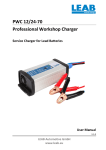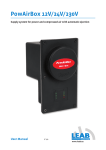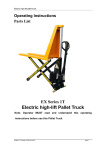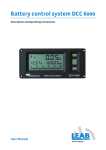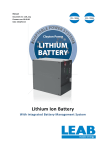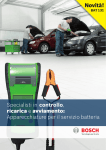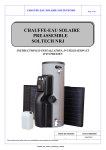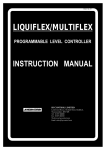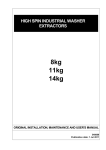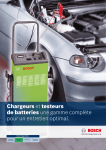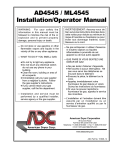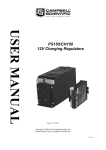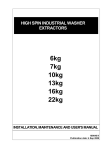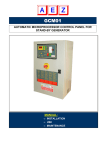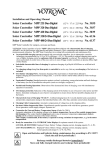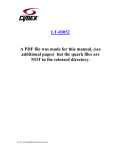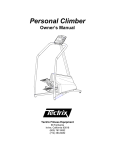Download User Manual CPC Charger
Transcript
CPC Compact Professional Charger Microprocessor controlled battery charger CPC 1215 CPC 1220 CPC 1230 CPC 1260 CPC 2415 CPC 2420 CPC 2430 CPC 2440 CPC 2450 CPC 2460 User Manual Ver. 1.0en LEAB Automotive GmbH www.leab.eu LEAB Automotive -CPC Important information about this documentation The technical data, information and illustrations have been put together carefully and correspond to the production status at the time the documentation was prepared. However, the manufacturer retains the right to improve or modify the products, specifications and documentation without notice at any time according to technical requirements and the latest development status. The descriptions have been prepared in detail and with great care. Nevertheless, errors can never be ruled out entirely. No liability will be accepted for errors of damage which could originate from these or from faulty interpretations. The contents of this documentation may not be copied, reproduced, translated or forwarded to third parties in any other way without the express permission of LEAB Automotive GmbH . Caution! Safety note, non-observance can lead to personal injury or material damage as well as impair the device function. Caution! Hazard through electric voltage Safety note, non-observance can lead to injuries and death as well as damage or destroy the device. Note Supplementary information on how to handle the device. LEAB Automotive GmbH Thorshammer 6 D-24866 Busdorf Germany www.leab.eu Important note on using the device To avoid operational errors, you should read this manual carefully before installation and before initial use, and always follow the respective instructions. Please keep this manual near the charger for future reference so that operators can use it to find out about the device's functions. Page - 2 - LEAB Automotive GmbH LEAB Automotive -CPC Contents Page Important note on using the device ..................................................................................................... 2 1. Scope of supply........................................................................................................................ 4 2. Performance characteristics and operating functions ........................................................... 5 2.1 Charging procedure.................................................................................................................. 5 2.2 Operation ................................................................................................................................. 6 2.3 Connection............................................................................................................................... 7 2.3.1 Battery in the vehicle ................................................................................................................ 7 2.3.2 Battery outside the vehicle ....................................................................................................... 7 2.4 Power supply function .............................................................................................................10 2.5 Control display and fault descriptions ......................................................................................11 2.6 Troubleshooting ......................................................................................................................12 2.7 Maintenance and service.........................................................................................................13 3.1 Specifications ..........................................................................................................................14 Technical data.........................................................................................................................14 3.2 Dimensional drawing ...............................................................................................................16 4.1 Installation ...............................................................................................................................16 CPC connections ....................................................................................................................17 4.2 Installation location..................................................................................................................17 4.3 Device installation ...................................................................................................................18 4.4 Conversion of charging cable (CPC 600W and 800W only) .....................................................19 4.5 Connection and conversion of the mains connection cable ......................................................19 4.6 Connection of remote display ..................................................................................................20 4.7 Connection of sensor cable .....................................................................................................21 4.8 Connection of CBL control relay (600/800W only) ....................................................................21 3. 4. Annex A ................................................................................................................................................23 Mains connection plug 230V ...............................................................................................................23 Annex B ................................................................................................................................................24 Use of lead-acid batteries ....................................................................................................................24 Battery maintenance .........................................................................................................................24 Open batteries ..................................................................................................................................24 Sealed batteries ................................................................................................................................24 Battery storage .................................................................................................................................25 Annex C ................................................................................................................................................26 Extent of Warranty ............................................................................................................................26 CE Declaration of Conformity..............................................................................................................27 LEAB Automotive GmbH Page - 3 - LEAB Automotive -CPC 1. Scope of supply With the LEAB battery charger CPC you have purchased a high-quality battery charger that you can use both permanently installed in vehicles and in mobile workshop applications. Please check before you use the charger whether the following items are included in the box: Battery charger CPC of the required voltage and output (see specifications on the rating plate) Mains connection cable 230VAC, 1.5 m long, with Schuko plug Battery charging cable 2x 6/10 mm², 1.5 m long, permanently attached English manual (this document) If the scope of supply does not correspond to these items, or the charger or connection cable are damaged, please contact your dealer or LEAB directly. If you should require a further copy of the manual, you can download this in PDF format from www.leab.eu free of charge. If you should require spare parts or accessories for your LEAB battery charger CPC, please see section 2.7 of this manual and send your order by email to [email protected]. Overview of available types: To make presentation easier, we distinguish between three series of CPC battery chargers depending on the capacity of the power supply. The basic properties such as dimensions, weights and electrical equipment are identical within one such group. Compare the technical data listed in Chapter 3. Series 600W Series 800W Series 1600W CPC 1215 CPC 1230 CPC 1260 CPC 1220 CPC 2420 CPC 2440 CPC 2415 CPC 2430 CPC 2450 CPC 2460 Page - 4 - LEAB Automotive GmbH LEAB Automotive -CPC 2. Performance characteristics and operating functions The portable battery charger LEAB CPC has been developed both for mobile use and stationary installation in vehicles for the charging of all types of lead batteries. Thanks to their compact design, high capacity and very good interference suppression, LEAB battery chargers have been used for years wherever optimum mobile battery charging is essential. Custom charging programs are available for special applications, and also provide a suitable solution for special applications such as the charging of traction or lithium batteries. 2.1 Charging procedure Battery charging takes place completely automatically and controlled by microprocessor with a three-stage IU1oU2 charging characteristic for optimum and gentle battery treatment. The charging parameters can be adapted to the type and capacity of the batteries to be charged during installation and before connection to the battery by selected one of the 15 characteristic curves stored in the device. Charging with constant current (I-phase, LED lights up orange) Depending on the battery's state of charge, maximum charging current is used in order to store as much energy as possible in the battery as quickly as possible. If an exhaustively discharged battery is connected for charging, the battery charger starts charging at reduced current to prevent damage to the battery. After the set main charging voltage has been reached (14.2 (28.4) to 14.4 (28.8) V depending on the battery type), the battery charger switches to the next charging phase. Charging with constant voltage (U1-phase, LED lights up orange) The actual full charging of the battery takes place in this phase. The voltage is kept contact at a value of 14.4 (28.8) V (setting gel/AGM) or 14.2 (28.4) V (setting wet cell). As the battery charge increases the current drops continually and approaches a lower limit which depends on the type and size of the battery. As soon as the value drops below this limit or a set minimum charging time has been exceeded, the battery charger switches to phase 3. Equalisation charging (U2-phase, LED lights up orange): only with the program for traction batteries Following the main charging phase, the electrolyte is stabilised, any sulphating of the plates is degraded. Depending on the battery type set, the voltage increases to up to 15.6 (31.2) V at reduced charging current. As soon as this phase has been completed the battery charger switches to phase 4. Maintenance charging with reduced voltage (U3-phase, LED lights up green) The charging voltage is reduced to 13.6 (27.2) V (setting wet cell) or 13.8 (27.6) V (setting gel/AGM) to keep the battery fully charged over an unlimited time. Physical self-discharge is compensated and the battery is kept fully charged until it is disconnected. During the maintenance phase LEAB CPC battery chargers can operate connected consumers up to the full capacity of the battery charger without any undesired return to main charging. The values specified are for 12 V charging setting (values for 24 V in brackets). LEAB Automotive GmbH Page - 5 - LEAB Automotive -CPC 2.2 Operation The correct charging characteristic must be set on the CPC battery charger before installation and connection to the battery. There are 15 charging characteristics (and one test setting) stored in the internal battery charger memory; these can be requested via a 16-level rotary potentiometer. Use the table on the characteristic sheet (delivered with the battery charger) to choose the appropriate setting for your application depending on battery type and capacity, and adjust the charger to this position by turning the potentiometer. Potentiometer Fig. 1 Position of the potentiometer and front display Attach the enclosed sticker in such a way that it covers the setting potentiometer and the recess is over the multi-colour LED. Refer to section 2.5 of this manual for details of the LED status display and the meaning of the colour code of the three-colour LED. Fig 2 LED status sticker Choose the correct battery type "Standard" (for wet cell batteries) or "Gel/AGM" (for sealed lead batteries using gel or AGM technology) from the characteristic sheet. Your batteries will only be charged perfectly when the correct setting has been made. See your battery data sheet for information on battery charging, or ask your battery supplier. If you have any questions about the correct charge setting, please contact LEAB or your battery manufacturer. Other charging programs for special applications are available on request. If batteries are charged using an unsuitable characteristic, their performance can be impaired and the battery will not reach its capacity. The wrong charging characteristic can damage or destroy the battery. Page - 6 - LEAB Automotive GmbH LEAB Automotive -CPC 2.3 Connection If you want to use the LEAB CPC as a mobile battery charger, please continue with section 2.3.2. 2.3.1 Battery in the vehicle Connect the two charging cables fixed to the LEAB CPC as follows: red end of the cable to the plus terminal of the battery (marked +) black end of the cable to the minus terminal of the battery (marked –) or an earth contact point provided near the battery. We recommend the use of a safety fuse in the plus cable with the following values: Type Fuse Crosssection CPC 1215 30 A 6 mm² CPC 1220 40 A 6 mm² CPC 1230 50 A 6 mm² CPC 2415 30 A 6 mm² CPC 2420 40 A 6 mm² Type Fuse Crosssection CPC 2430 50 A 6 mm² CPC 1260 75 A 10 mm² CPC 2440 75 A 10 mm² CPC 2450 75 A 10 mm² CPC 2460 75 A 10 mm² The cross-sections of the charging cables must not be reduced. We recommend keeping the charging cables as short as possible and not extending them. There are three sockets on the back of the CPC battery charger (only 2 sockets on the CPC 1600W) which can be used to connect additional devices (see section 4.6ff). Assignment is as follows: Remote display Temperature/voltage sensor CBL relay (not CPC 1600W) 2.3.2 Battery outside the vehicle Connect the two charging cables to the battery terminals as follows: red end of the cable to the plus terminal of the battery (marked +). blue end of the cable to the minus terminal of the battery (marked –). Only use suitable battery terminal clamps and protective pole caps such as the ones you can find in our range at http://shop.leab.eu. 230V mains connection There is a connection socket for the 230V mains cable on the back of the CPC battery charger. The plug system of the type Neutrik can be locked, thus guaranteeing safe and vibration-resistant contact in every vehicle, yet providing maximum flexibility during installation and removal. Please refer to Annex A LEAB Automotive GmbH Page - 7 - LEAB Automotive -CPC in this manual for information about attaching and releasing the plug-type connections as well as assembly instructions for preparing new connection cables. Starting charging Connect the mains plug to a Schuko socket in your building installation, thus switching the CPC battery charger on. After the device has been connected to the mains, the operational LEDs start to flash red for 2 seconds while the battery charger checks whether or not a battery is connected. If the LED lights up orange, charging is taking place according to the set program. Never switch the battery charger on until the connection to the battery has been established. Otherwise a fault message will be issued and the battery will not be charged. No charging takes place as long as the red LED lights up or flashes. Battery voltage 12 V (one battery) After a few seconds the CPC starts in the selected program and automatically charges the connected battery until it is fully charged. If the orange setting LED and the red Error LED are flashing alternately despite correct voltage, please check the battery voltage. If the voltage is less than 8 V the CPC will not start charging for safety reasons, in order to avoid potential hazards caused by exhaustively discharged batteries*. As soon as the battery is fully charged, the LED display changes from orange to green and the charging voltage is reduced to maintenance charging. The battery can now be disconnected or remain connected to the battery charger until it is used. The CPC ensures that the battery remains fully charged in the meantime, independently of the time involved. * Only with charging program with start voltage > 0 V. Choose the correct battery type Standard (for wet cell batteries) or Gel/AGM (for sealed lead batteries using gel or AGM technology). Your battery will only be charged correctly in this case. Individual batteries with a voltage of less than approx. 8 V will no longer be charged in the charging setting of the CPC for safety reasons: Exhaustively discharged batteries must be pre-charged for several hours using a power supply (charging program with start voltage 0 V even charges exhaustively discharged batteries). Page - 8 - LEAB Automotive GmbH LEAB Automotive -CPC Battery voltage 24 V (two batteries in series) After a few seconds the CPC starts in the selected program and automatically charges the connected battery until it is fully charged. If the orange setting LED and the red Error LED are flashing alternately despite correctly set voltage, please check the voltage of the batteries. If the voltage is less than 20 V the CPC will not start charging for safety reasons, in order to avoid potential hazards caused by exhaustively discharged batteries*. Please pre-charge the batteries separately. As soon as the battery is fully charged, the LED display changes from orange to green and the charging voltage is reduced to maintenance charging. The battery can now be disconnected or remain connected to the battery charger until it is used. The CPC ensures that the battery remains fully charged in the meantime. * Only with charging program with start voltage > 0 V. Choose the correct battery type Standard (for wet cell batteries) or Gel/AGM (for sealed lead batteries using gel or AGM technology). Your battery will only be charged correctly in this case. Depending on the state of charge and size of the battery to be charged, it can take up to 18 hours for the batteries to be fully charged again. Batteries which are connected up to 24 V and have been exhaustively discharged to under 20 V must always be charged individually to avoid any further damage; use a 12 V battery charger for this. If sealed lead batteries (gel or AGM) are charged for longer periods with excessively high voltage they can gas and dry out, thus destroying the battery. Open wet cell batteries consume water during charging. Water must thus be refilled regularly. If you are not sure how to charge your batteries, please contact your specialist dealer. Discharged batteries must be recharged without delay, otherwise they can be destroyed. LEAB Automotive GmbH Page - 9 - LEAB Automotive -CPC 2.4 Power supply function CPC batteries chargers with a charging program with start voltage 0 V* can also be used without a battery to supply DC consumers up to the maximum capacity of the battery charger. In this case it must be noted that the output voltage is reduced after a short time from the higher main charging voltage to the lower maintenance charging voltage. This allows vehicles to be supplied with voltage even when the battery has been removed, thus avoiding the time-consuming and tedious re-programming of customer settings in the on-board computer and radio system. LEAB can equip all CPC battery chargers with the suitable power supply program* for exclusive use as a power supply. Please contact LEAB Service in this case. Charging programs must be stated in your order for the CPC battery charger so that they can be installed in the battery charger. * Optional extra Power supply function is only available for devices with start voltage 0 V or with special power supply program. The power supply output is resistant to short-circuit and overload, but longer shortcircuit should still be avoided to prevent the charging cable and LEAB CPC becoming too hot. The optional power supply program is also suitable for pre-loading exhaustively discharged batteries which are no longer detected by a battery charger for a few hours or for regenerating them. If you would like to use the LEAB CPC in combination with diode distributors or the charging current distributor LEAB CDB, you must always choose a charging characteristic with 0 V start voltage. Page - 10 - LEAB Automotive GmbH LEAB Automotive -CPC 2.5 Control display and fault descriptions The control lamp (three-colour LED) on the front of the device indicates the different operating and fault statuses: The different statuses are indicated by permanent or flashing light. See section 2.2 on the position of the LED. LED display on the battery charger LED Status Description Measure Permanent light orange Battery is being charged, the CPC is in the main charging phase none Permanent light green Battery fully charged, the CPC is in the maintenance charging phase The battery charger can be unplugged and the battery used Permanent light red No battery connected or connected battery exhaustively discharged Check the battery connection, measure the battery voltage, pre-charge the battery using the power supply* Flashing red Time exceeded in the main charging phase, charging interrupted Battery faulty: Check battery Battery too large for the battery charger: choose larger battery charger Parallel consumers too large: Switch consumers off during charging Table 1: LED display on the CPC battery charger * Pre-charging is not necessary for programs with start voltage 0 V LED display on the optional remote display If you have the optional LED remote display installed (see section 4.5), the CPC statuses will also be displayed there in the same way as described above. LEAB Automotive GmbH Page - 11 - LEAB Automotive -CPC 2.6 Troubleshooting If your LEAB CPC is not working as it should, please try to localise the fault using the following procedure first. If this is not successful, please contact your specialist dealer or LEAB. Have the serial number and date of purchase on hand as well as an accurate description of the fault so that we can help you as quickly as possible. LED display on the battery charger. The figures refer to the corresponding chapters in this manual. Battery is not being charged ye s Is the LED lit green? - Maintenance charging - check voltage no Is the LED lit orange? ye s - Main charging - Check charging program (2.3) - Check battery voltage - Battery faulty no Is the LED lit red? ye s no Lock Neutrik connector no Is the Neutrik connector locked? ye s Insert mains plug no Is the mains plug inserted? ye s Switch the mains fuse on no Is the mains fuse OK? ye s Contact LEAB Service Page - 12 - LEAB Automotive GmbH Is the LED flashing red? ye s - Connect battery (2.3); - Check voltage - Select power supply function (2.4); - Check charging cable no - Connect battery (2.3); - Check voltage - Select power supply function (2.4); - Check charging cable LEAB Automotive -CPC 2.7 Maintenance and service Regular tests Check the battery charger before every use as follows: Are the mains cable and mains plug undamaged? Are the charging cable and connections undamaged? Is the charging cable fixed safely to the battery charger? Is the outside of the battery charger undamaged and not opened? Has the battery charger been in contact with water, oil or other fluids? When used for commercial applications, the LEAB CPC battery charger is mobile electrical operating equipment in the sense of the German accident prevention regulation BGV-A3 or is subject to other regulations of the employers' liability association, depending on deployment and use. This employers' liability association regulation prescribes the regular testing of electrical devices for electrical safety (usually once a year). Please clarify with your employers' liability association whether you are affected by this or any comparable regulation and take the measures necessary for the safety of your employees. Your employers' liability association or work accident insurance company will be able to provide more information. Check the battery charger and cable for damage before you use the device. Do not used a damaged device or a device with damaged connection cables; have it repaired without delay. Have the device checked if it has been in contact with fluids. Have the device checked regularly by a qualified electrician. Always have any necessary repairs done exclusively by LEAB. Spare parts, accessories The following spare parts and accessories can be ordered from LEAB Service at [email protected] or in the LEAB shop at http://shop.leab.eu under specification of the article number: Pos. Description Article number 1 CTS, 2.5 * 1601035593 2 TS, 3.1m* 1601036708 3 CBL set 1601355997 4 Mains cable 1.5 m Neutrik connector / Schuko plug D 1601001122 5 Mains cable 1.5 m Neutrik connector / mains plug CH 1601001123 6 Neutrik connector NAC3FCA blue, single (set) 0205900023 7 Remote display ABC, LED with 5 m cable, RJ45 1401036720 8 Remote display ABC, LED with 12 m cable, RJ45 1401036730 Table 3 Accessories * also available in other lengths on request. LEAB Automotive GmbH Page - 13 - LEAB Automotive -CPC 3. Specifications 3.1 Technical data Model CPC 1215 CPC 1220 CPC 1230 CPC 2415 CPC 2420 CPC 2430 Article number 0101036900 0101036901 0101036930 0101036902 0101036903 0101036931 Battery Type of battery Open and sealed lead acid, lead gel, AGM batteries Charging characteristic Rec. battery capacity Choice of 15 characteristics (see characteristic sheet) 50-150 Ah 60-200 Ah 90-300 Ah 50-150 Ah 60-200 Ah 90-300 Ah Charging current, maximum 15 A 20 A 30 A 15 A 20 A 30 A Charging current, permanent 15 A 20 A 30 A 15 A 20 A 30 A Charging current Ripple <3% Charging voltage Main charging 14.2/14.4 V 28.4/28.8 V Equalisation charging* 15.6 V 31.2 V Maintenance charging 13.6/13.8 V 27.2/27.6 V Supply voltage (AC) Input voltage (nominal values) 230 V / 50 Hz / 4 A Input voltage range 90 … 270 V (< 200 V reduced charging current) Input frequency range 0 … 400 Hz Standby current (from the battery) < 2 mA Switching frequency 100 kHz Recommended mains fuse protection B16 A or C16 A Maximum efficiency > 88 % Class of protection I Operating temperature range -30 … +60° C IP protective rating IP 20 Housing dimensions 264 x 127 x 86 mm (length x width x height) Weight (without cable) 1.5 kg Connection cable Twinflex charging cable 2x6 mm², length 1.5 m Mains cable 1.5 m Neutrik connector / Schuko plug Weight (accessories) Charging cable 1.5 m: 0.2 kg / Mains cable 1.5 m: 0.2 kg Table 4 Technical data CPC 600W/800W Page - 14 - LEAB Automotive GmbH LEAB Automotive -CPC Model CPC 1260 CPC 2440 CPC 2450 CPC 2460 Article number 0101036970 0101036971 0101036972 0101036973 Battery Type of battery Open and sealed lead acid, lead gel, AGM batteries Charging characteristic Rec. battery capacity Choice of 15 characteristics (see characteristic sheet) 150-600 Ah 120-400 Ah 140-500 Ah 150-600 Ah Charging current, maximum 60 A 40 A 50 A 60 A Charging current, permanent 60 A 40 A 50 A 60 A Charging current Ripple <3% Charging voltage Main charging 14.2/14.4 V 28.4/28.8 V Equalisation charging* 15.6 V 31.2 V Maintenance charging 13.6/13.8 V 27.2/27.6 V Supply voltage (AC) Input voltage (nominal values) Input voltage range Input frequency range 230 V / 50 Hz / 8 A 90 … 270 V (< 200 V reduced charging current) 0 … 400 Hz Standby current (from the battery) < 2 mA Switching frequency 100 kHz Recommended mains fuse protection Maximum efficiency B16 A or C16 A > 88 % Class of protection Operating temperature range I -30 … +60° C IP protective rating IP 20 Housing dimensions 294 x 135 x 95 mm (length x width x height) Weight (without cable) Connection cable 2.2 kg Twinflex charging cable 2x10 mm², length 1.5 m Mains cable 1.5 m Neutrik connector / Schuko plug Weight (accessories) Charging cable 1.5 m: 0.2 kg / Mains cable 1.5 m: 0.2 kg Table 5 Technical data CPC 1600W * EQ charging only with charging characteristic for traction batteries (option) LEAB Automotive GmbH Page - 15 - LEAB Automotive -CPC 3.2 Dimensional drawing Fig. 3 Dimensions CPC 600W/800W (left) and CPC 1600W (right) 4. Installation The LEAB CPC has been designed primarily as a built-in battery charger but it can also be used as a transportable service battery charger. The sturdy rubber corners make stable yet vibration-absorbing attachment possible, allowing it the be set down or mounted to sensitive surfaces without causing any damage. However, since the charging cables do not have an additional strain relief fixture, we recommend changing to the type LEAB PWC if you wish to use the device permanently as a service battery charger. The device feet have suitable seats for attachment bolts for permanent installation, allowing the CPC to be attached vertically or horizontally to a wall or table (see section 4.2). Page - 16 - LEAB Automotive GmbH LEAB Automotive -CPC 4.1 CPC connections Neutrik connection 230V + - + - Connection plus charging cable Connection minus charging cable RJ45 connection CBL relay (not 1600W) RJ45 connection sensor cable RJ45 connection remote display Fig. 5 View of CPC from the back, connection side 4.2 Installation site The following environmental conditions must be given if you want to install the battery charger for stationary use: Choose a dry and dust-free spot, not too hot, for installation. The LEAB CPC can be attached horizontally to a level panel as well as horizontally or vertically to a wall. Optimum cooling is achieved with the LED side facing downwards. Make sure there is sufficient and unobstructed cooling air flow so that the heat produced can be dissipated safely. Do not install the device directly next to or above inflammable materials. Never install the battery charger in the direct vicinity of open wet cell batteries. The acid vapours produced during charging can corrode and thus destroy the PCB and other components. Do not use a charging cable with a cross-section smaller than the one delivered with the device. Protect your battery charger from excessive heat impact. This reduces performance and can shorten the service life. Heed the installation guidelines for other devices (e.g. radio-controlled devices) to avoid mutual influence. Never charge with the charging characteristic set incorrectly. The battery can become damaged. LEAB Automotive GmbH Page - 17 - LEAB Automotive -CPC Dry, well ventilated and dust-free installation location. Keep the distance to the batteries as short as possible to achieve short cable lengths. Do not install the device directly next to or above the batteries. The device must be protected from the effect of dust and humidity. Make sure that the fan can intake cooling air freely. Do not install the device directly next to or above inflammable materials. 4.3 Device installation Install the device on a level horizontal or vertical surface. The four recesses on the rubber feet are for attachment. Use screws with a diameter of 5 mm. The built-in fan guarantees optimum cooling independently of the direction of installation. Dimensional drawings can be found in section 3.2. Vertical installation option Attachment screws 5 mm Fig. 5 Attachment CPC Page - 18 - LEAB Automotive GmbH LEAB Automotive -CPC 4.4 Conversion of charging cable (CPC 600W and 800W only) Depending on the application, it can be necessary to replace the charging cable fitted to the LEAB CPC. This can be due to cable damage or in order to fit a cable of a different length than the one already fitted. Standard electric cables of the corresponding cross-section can be used as replacement cables. To remove the charging cable, disconnect the LEAB CPC from the mains and from the battery. Use a slim screwdriver to carefully release the two clamp locking mechanisms on the cable terminals which are used to attach the charging cables to the charging output and pull the old charging cables out. Push the stripped ends of the new charging cables completely into the terminal guides. To do this, twist the ends of the wires slightly and release the locking mechanism using a screwdriver before pushing the ends in. Pull the screwdriver out when the cables have been pushed in completely so that the locking mechanism can grip tightly. Pull the new charging cable firmly a few times to check whether the locking mechanism holds. Note the polarity specifications on the label next to the charging output. Connect the red charging cable to the left-hand output marked + and the blue or black charging cable to the right-hand output marked –. 4.5 Connection and conversion of the mains connection cable When the LEAB CPC is mounted on the wall or used as a transportable battery charger, the 1.5 m mains connection cable delivered with the device may not always be sufficient and may need replacement. To make this modification easier for you, the mains connection cable is connected to a Neutrik connector system. See Annex A of this manual for instructions on fitting the Neutrik connector. To insert and remove the mains connection cable to and from the battery charger, please proceed as follows: separation engagement Engagement Separation Insert the blue Neutrik connector on the mains cable into the jack on the back (connection side) of the LEAB CPC (1) and turn the connector clockwise (2) until you hear a quiet click indicating successful locking. Pull the silver locking lever (1) towards you and turn the connector anti-clockwise (2) as far as it will go until you can pull the connector out of the jack (3). LEAB Automotive GmbH Page - 19 - LEAB Automotive -CPC If you require a longer mains connection cable or one with a plug other than the 250 V/16 A Schuko plug delivered with the device as standard, please contact LEAB or your specialist dealer. We can make customised connection cables for you at a favourable price. We expressly advise against modifying the connection cable yourself, fitting other plugs or making new cables. The respective national guidelines (e.g. VDE, DIN in Germany) or guidelines from the associations responsible (accident prevention regulations for example) must be followed when connecting the device to an existing 230 V installation. This work may only be carried out by an appropriately trained electrician. The LEAB CPC corresponds to protection class I and requires a protective earth conductor to be connected. For permanent installation we recommend a cable cross-section of 3x 1.5 mm². 4.6 Connection of remote display There is also an LED remote display optionally available from LEAB for connection to the RJ45 jack on the back of the device (refer also to the drawing in section 4.1). This remote display can be used to display the status of the built-in LED, providing an additional display of the status of charge and charging parameters for a permanently installed battery charger. Refer to section 2.5 for details of the display and appearance of different LED states. Fig. 6 Remote display with connection cable Page - 20 - Article number and type for the remote display can be found in the spare parts and accessories list in section 2.7 of this manual. LEAB Automotive GmbH 4.7 LEAB Automotive -CPC Connection of sensor cable There is also two sensor cables optionally available from LEAB for connection to the RJ45 jack on the back of the device (refer also to the drawing in section 4.1). CTS cable: Sensor for temperature and voltage This sensor cable is used to measure the temperature in the battery environment as well as the voltage directly at the battery terminal, and then transmit this to the CPC battery charger. The CPC corrects the charging voltage depending on the temperature, in order to achieve optimum efficiency and yet gentle battery charging at all times, no matter the temperature. By measuring the voltage at the battery terminals, the CPC can compensate the drop in voltage on the charging cable, thus making faster and more efficient charging possible even with long charging cables. We recommend the use of the combined CTS sensor cable where charging cables longer than 3 m are used. TS cable: Sensor for temperature This sensor cable can be used to measure the temperature in the direct environment of the battery and transmit this to the CPC battery charger. The CPC corrects the charging voltage depending on the temperature, in order to achieve optimum efficiency and yet gentle battery charging at all times, no matter the temperature. We recommend the use of the TS temperature sensor cable where charging cables up to 3 m in length are used. Available versions can be found under "Accessories" in section 2.7. 4.8 Connection of CBL control relay (600/800W only) There is a potential-free changeover contact installed in the battery charger versions of the LEAB CPC series 600W and 800W which switches during charging operation. There is a suitable adapter cable set with RJ45 connector and three open cable ends available for more straightforward connection. This option can be used for example as an electrical ignition interlock for a 230 V connection or for charging monitoring. Fig. 7 Connection assignment and technical data for switched output CBL LEAB Automotive GmbH Page - 21 - LEAB Automotive -CPC General notes The charging output is short-circuit-proof: no hazardous state occurs for the device even when the charging cable is connected directly. The charging output is protected against inverse polarity: the battery or the CPC will not be damaged if you mix up the battery connections; charging is not possible with inverse battery connections. Sparks can fly if the charging cable is connected to a battery with the battery charger switched on. Make sure there is a good electrical contact, clean the battery terminals before connection if necessary. All-round rubber edges protect any sensitive surfaces the device is set down on. Keep the rubber feet in particular clean of dirt and solvents so that this protection effect is not jeopardised. Always connect the charging cables to the battery terminals first before you connect the device to the mains in order to avoid sparking. Always select the charging program to match the type and size of battery on the CPC; the wrong selection can lead to the battery not being charged correctly or becoming damaged due to excess charge. Protect the battery charger from water and humidity. Check the battery charger regularly for damage and replace any faulty or worn connection cables immediately. Do not open the device, there are no components the user can operate inside the device. Clean the device feet regularly and do not expose them to acids, oil and aggressive cleaning agents. When charging refillable lead-acid batteries open the cover so that any gases produced can escape. Clean the air inlets and outlets regularly if heavily soiled. Page - 22 - LEAB Automotive GmbH LEAB Automotive -CPC Annex A Mains connection plug 230V The following non-interchangeable connector is used for the 230V mains connection cable: AC input connector, type Neutrik NAC3FCA – blue The connector is available as a spare part from LEAB under the article number 0205900023. Operation of Neutrik connector separation engagement Fitting the Neutrik connector A-type coding (blue) Cable preparation Sleeve Insert Clamping piece LEAB Automotive GmbH Connections Union nut Page - 23 - LEAB Automotive -CPC Annex B Use of lead-acid batteries Handling lead-acid batteries can be hazardous. These batteries produce explosive gases. If metal tools are used for work on batteries, it is important that the plus and minus terminals can never be touched at the same time. A short-circuit through a solid metal tool can lead to the battery exploding. If acid splashes onto the skin and eyes in particular, rinse the parts affected with clear water and seek medical advice immediately. The installation location for batteries must be well ventilated. Smoking and naked flames are prohibited during work on batteries. Regular recharging and maintenance will extend the service life. Battery maintenance Lead batteries, including ones which are not currently in use, must be recharged and serviced regularly. This should take place at least once a month during the warm seasons and every three months in the cold seasons. Older and poorly maintained batteries should be checked every two weeks. Open batteries The fluid level in open batteries should be checked, and the acid density measured using an acid siphon. They must be recharged if necessary. A clean and dry battery surface will lead to a longer service life. Soiling and any acid marks should be removed carefully. This can be done using warm water and a soda solution. Then rinse off with clear water and dry carefully. Make sure that the ventilation caps have been fitted cleanly and correctly. In addition, the connection terminals must be checked for a tight fit. The terminal screws should always be tightened. Make sure that the cell grids are covered with acid. Only distilled water may be used for topping the battery up. Never use normal drinking water. Do not fill up with too much water, this would reduce the acid density and thus the battery capacity (heed manufacturer instructions). Sealed batteries Sealed batteries are low-maintenance. The acid is bound through gel or in a fleece (AGM) and can therefore not evaporate. Testing is limited to measuring the battery voltage. To achieve a plausible result, the battery must not have been charged for several hours prior to testing. However, simply testing the voltage is not necessarily sufficient, since sulphating can increase voltage even if capacity is reduced. More accurate conclusions can only be drawn by using a suitable battery tester e.g. Midtronix MDX for tests. Page - 24 - LEAB Automotive GmbH LEAB Automotive -CPC Summary of maintenance points: Make sure that batteries are always fully charged (only use suitable high-quality battery chargers such as LEAB CPC). Do not part-charge batteries if possible. Regular charging reduces the risk of irreversible, permanent sulphating. Open wet cell batteries must be topped up regularly using distilled water. Battery surface and terminals must be dry and clean. The connection terminals must be covered with terminal grease. Do not expose batteries to a hot environment. Check the connection terminals for a tight fit at least once a year. Replace any batteries which bulge, are cracked or leaking. Battery storage Store batteries in a cool but frost-free and dry environment. Never store batteries in a discharged state. They should be charged to at least 75%. If batteries are stored for longer periods, check their state of charge at regular intervals and recharge if necessary. In very cold environments continuous maintenance charging prevents the battery freezing. LEAB Automotive GmbH Page - 25 - LEAB Automotive -CPC Annex C Extent of Warranty Providing installation has been carried out professionally and the devices are used according to their intended purpose, LEAB offers mandatory warranty over a period of 24 months after the date of purchase. If any defects of faulty functions should occur during this period under normal conditions of use, LEAB will either repair the device free of charge or replace it at their own discretion. New or repaired parts of equal value can be used for replacement. A warranty claim cannot be recognised under the following circumstances: The device was not used in accordance with the recommendations given in this manual. The device was used for purposes other than general automotive, solar, industrial or maritime applications without prior agreement with LEAB. The device was repaired or modified without express permission from LEAB. The device shows signs of damage caused by excess charge, penetration of humidity (water, oil, acid), mechanical force, excess or insufficient voltage or any other non-intended use. Pre-conditions for warranty payments Warranty claims can be made to your specialist dealer or LEAB directly. The following documents are required: Invoice or delivery note Model description or type Serial number Detailed description of the fault and installation, if appropriate Procedure If the device cannot be put back into operation perfectly according to the instructions in this manual or if the fault persists, contact your dealer's Service department or LEAB directly. If this is no help either, please request a processing form and processing number (RMA number) as well as a free UPS pick-up sticker (free UPS pick-up service unfortunately only possible without Germany) by calling +49 (0)4621 - 97860-120 or sending a mail to [email protected]. You can send the defective device to us together with these documents. We will then examine it and repair it if necessary. Page - 26 - LEAB Automotive GmbH LEAB Automotive -CPC CE Declaration of Conformity The product LEAB CPC with the types CPC 1215, CPC 1220, CPC 1230, CPC 1260 CPC 2415, CPC 2420, CPC 2430, CPC 2440, CPC 2450, CPC 2460 complies with the requirements of the directives 2006/95/EC, 2004/104/EC and 2005/83/EC. The following harmonised standards were used: EN 60335-2-29:1996 + A11:97 (IEC335-2-29:2002 modified) EN 60335-1:1994 + A11:95 + A1:96 +A12:96 + A13:98 + A14:98 + A15:00 + A2:00 + A16:01 as well as EN 61204-3:2000 EN 50366:2003 + A1 Busdorf, 01.07.2013 Bart Westerkamp Managing Director LEAB Automotive GmbH Page - 27 - LEAB Automotive -CPC LEAB Automotive GmbH Thorshammer 6 D-24866 Busdorf Germany Fon: +49 (0)4621-97860-110 Fax: +49 (0)4621-97860-260 Email: [email protected] www.leab.eu LEAB is certified to ISO 9001:2008 and 14001:2004 Page - 28 - LEAB Automotive GmbH




























